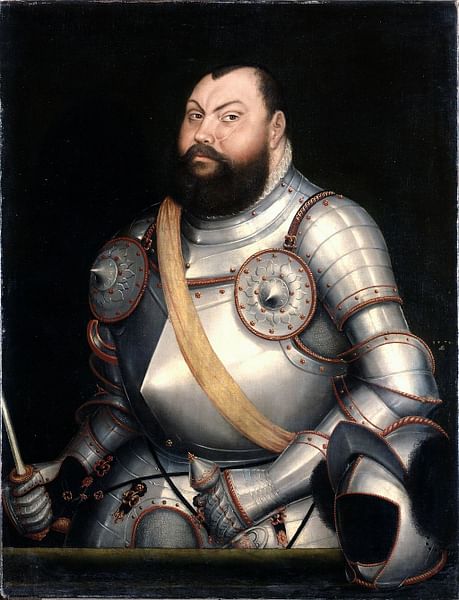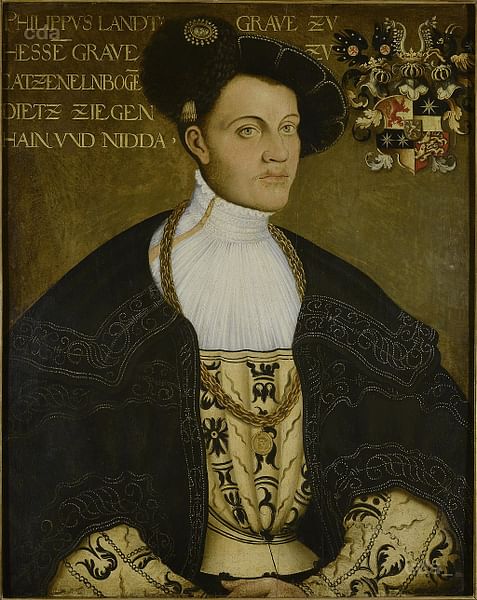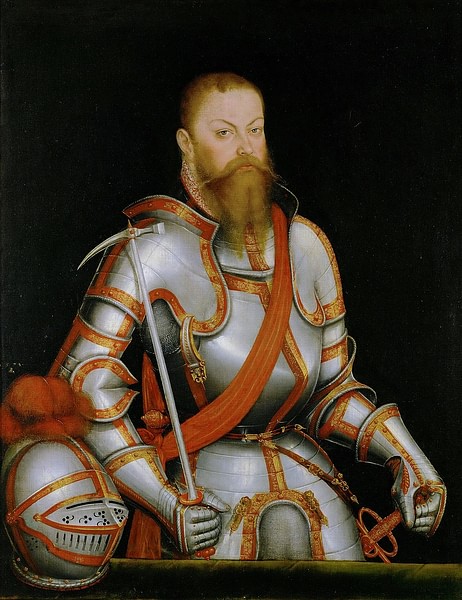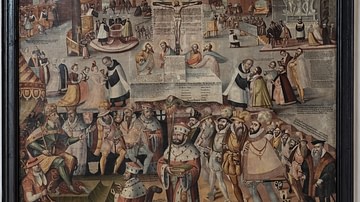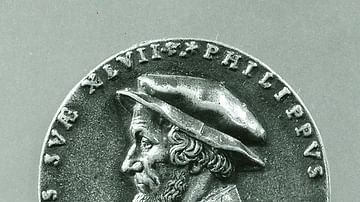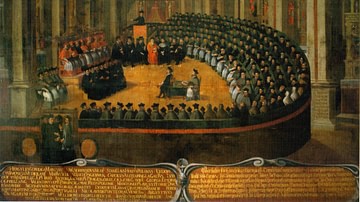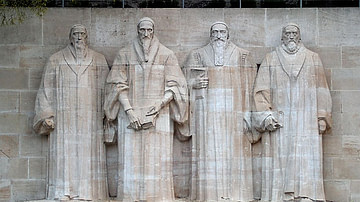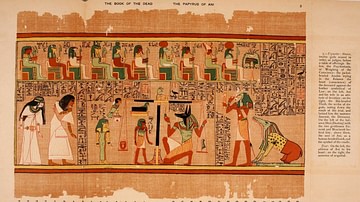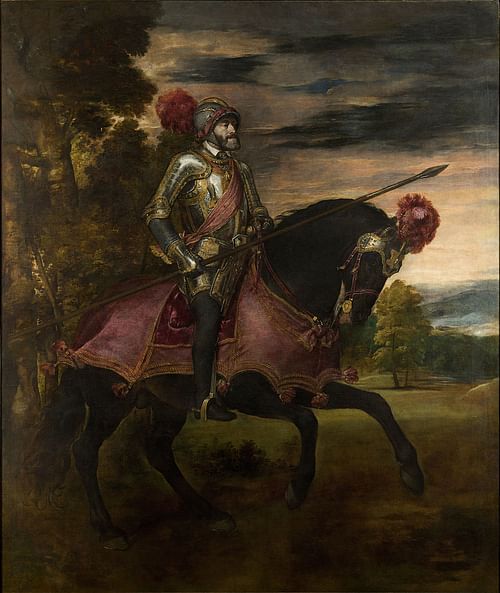
The Schmalkaldic War (1546-1547) was fought between the Protestant Schmalkaldic League and the Catholic armies under Charles V, Holy Roman Emperor, who, having failed to achieve religious unity of his subjects at the Diet of Augsburg in 1530, sought to impose it by force. Charles V won the war but was unable to suppress the Protestant movement.
The Imperial Diet of Augsburg had been convened by Charles V (r. 1519-1556), in part, to unify his subjects against the threat of an invasion by the Turks of the Ottoman Empire. The German reformer Martin Luther (l. 1483-1546) had begun the Protestant Reformation in 1517, splitting the previously unified Catholic Church, and his efforts had encouraged others, such as Huldrych Zwingli (l. 1484-1531), to advocate for reform as well. The result, by 1530, was animosity and division not only between Protestants and Catholics but between different Protestant sects.
The Lutherans presented their Augsburg Confession, written by Philip Melanchthon (l. 1497-1560), at the diet in an attempt to clarify their beliefs and reach an accord with Catholics. The Confession was rejected, and negotiations failed to reach a compromise. Afterwards, the Schmalkaldic League, a military alliance, was formed by the Lutheran princes who feared Charles V would force their conversion to Catholicism. When this did not materialize, the league advanced their agenda by confiscating Catholic lands and establishing the Lutheran Christian vision in Germany.
Charles V had not forgotten about the German Protestants, however; he had only been busy fighting other wars. In 1546, he sent his armies under the command of Fernando Álvarez de Toledo, the 3rd Duke of Alba (l. 1507-1582), to deal with the problem. Charles V's able manipulation of the Protestant prince Maurice, Elector of Saxony (l. 1521-1553), the neutrality of some nobles who could have helped the Protestant side, the brilliance of the Duke of Alba, and, probably most significantly, the inability of the Lutheran princes to present a united front led to a Catholic victory and the end of the Schmalkaldic League.
The Second Schmalkaldic War was fought in 1552 after Charles V, hoping to unite Protestants and Catholics through a decree, had issued his Augsburg Interim that only increased tensions. The Protestants won the Second Schmalkaldic War, forcing Charles V to realize he would be unable to suppress the Protestant movement. The Lutherans were recognized as a legitimate religious entity at the Peace of Augsburg in 1555, though other Protestant sects, such as the Calvinists, were still persecuted, and religious tensions remained unaddressed.
Reform, Division, & Augsburg Confession
In 1517, when Martin Luther's 95 Theses sparked the Protestant Reformation, Germany was part of the Holy Roman Empire, and there was only one religious authority in Europe: the Roman Catholic Church. Luther's protest against the Church's policy of selling indulgences – writs that were claimed to shorten one's time in purgatory – inspired a widespread revolt against ecclesiastical authority and, since the Church was intimately tied to the various monarchies, against the established order.
Luther was excommunicated in 1521, and after his appearance at the Diet of Worms, he became a rallying point for those who viewed the Church as supporting the unjust and inequitable policies of nobles who benefited from the near-slave labor of the peasantry. Luther's speech at the Diet of Worms, transcribed and published in the vernacular, gave hope to many that a new religious vision would now replace that of the Catholic Church and lead to social and cultural reform. The German Peasants' War (1524-1525) was the first expression of this hope, but other regions also began advocating for reform, splintering the religious unity of Europe.

Charles V had declared Luther an outlaw through the Edict of Worms, but he had become so popular that he could not be arrested, and as he was supported by the powerful noble Frederick III (the Wise, l. 1463-1525), he was able to continue writing and publishing his teachings, encouraging more converts to the new Protestant faith. In 1522, in Zürich, Zwingli publicly broke with the Church and established the Reformation there while, at the same time, other groups within the Protestant movements of Luther and Zwingli began articulating their own visions.
The result was that, by 1530, Europe was in religious and social turmoil, and Charles V called for a conference at Augsburg, which he hoped would resolve the issues and bring the Protestants back under the authority of the Church. Charles V was especially concerned over these divisions as he expected an invasion by the Ottoman Empire and needed a united citizenry to counter any such attack. Luther's delegation presented the Augsburg Confession to Charles, a document clarifying Lutheran beliefs and refuting Catholic teachings and policies, which Melanchthon had carefully worded in the hopes the two could reach a compromise. The Augsburg Confession was rejected by Charles and the Catholic delegation, however, and the religious divisions only escalated.
The Schmalkaldic League
A number of German nobles had embraced Luther's vision, including John Frederick I, Elector of Saxony (l. 1503-1554), eldest son of Elector John (John the Steadfast, l. 1468-1532), the younger brother of Frederick III, the Wise. Aligned with John Frederick was Philip I of Hesse (l. 1504-1567) who, like John Frederick's family, was a strong supporter of Luther's movement. After the negotiations at the Diet of Augsburg failed, these nobles (and others) became concerned that Charles V would force the unity he sought by military action, and so they met at the town of Schmalkalden in Germany and formed a military alliance, the Schmalkaldic League, in 1531. Scholar Diarmaid MacCulloch comments:
At the end of 1530, the evangelical princes and cities of the Empire decided that they must create a defensive league against the possible attack by Catholics now that the Emperor had rejected Protestant overtures: they agreed their alliance in the Hessian town of Schmalkalden. Until its destruction in the late 1540s, this Schmalkaldic League was the most powerful Protestant political force in Europe, and what is particularly significant about all its political and military activities is that they were inspired by religious zeal. The League was only in existence to do God's work; it was not merely a diplomatic association of convenience. This did not bode well for the future peace of Europe. (174)
To join the League, one had to agree to the tenets of the Augsburg Confession and also promise military assistance to other members, regardless of how well or poorly one's relationship might be with them otherwise. The League, therefore, was initially a tightly focused group prepared to defend German lands against Catholic aggression. Charles V, however, had other problems at hand in the form of various foreign wars, and so the German nobles were left alone. Finding themselves free to do as they pleased, they seized Catholic lands and dissolved monasteries and convents, repurposing the buildings for the common good.
Although the Lutheran princes were sincere in their desire to defend the new faith from the old, they were equally motivated by self-interest in that formerly Catholic lands were now at their disposal and could significantly enrich them. Between 1531 and 1544, the princes continued their policies which provided the stability in the region necessary for the spread of Luther's doctrines and the establishment of the Lutheran Church. In 1544, however, Charles V ended his conflicts elsewhere and returned to the problem of his divisive German subjects.
Charles V & the Princes
Charles V began the war before any armies were fielded by approaching Maurice of Saxony, cousin of John Frederick, and promising him John's title and lands in return for his military allegiance. Maurice hated his cousin and was happy to help the emperor in any effort to be rid of him but was torn in his loyalties as Philip I of Hesse was his father-in-law and they had formed a warm relationship. Even so, Maurice's desire for more land and greater power outweighed his feelings for Philip, and he sided with Charles V.
Charles V then encouraged his younger brother, Ferdinand I (l. 1503-1564), who could command a large force as King of Bohemia, Hungary, and Croatia as well as Archduke of Austria, to declare neutrality in the coming conflict, and did the same with William IV, Duke of Bavaria (l. 1493-1550). William IV had initially favored the Protestant cause but had become as alarmed as Charles V at the divisions and social chaos it encouraged. Charles V's negotiations with these princes deprived the Schmalkaldic League of possible allies and also provided him with a staging area for his invasion force.
Having arranged for his invasion, he then chose the Duke of Alba to lead it. Fernando Álvarez de Toledo, 3rd Duke of Alba, had been a soldier since he was 17 and had proven himself an effective military leader numerous times. He had served Charles V against the Ottoman Turks and in the wars with France since 1532 and was confident he could take care of a few rebellious German princes.
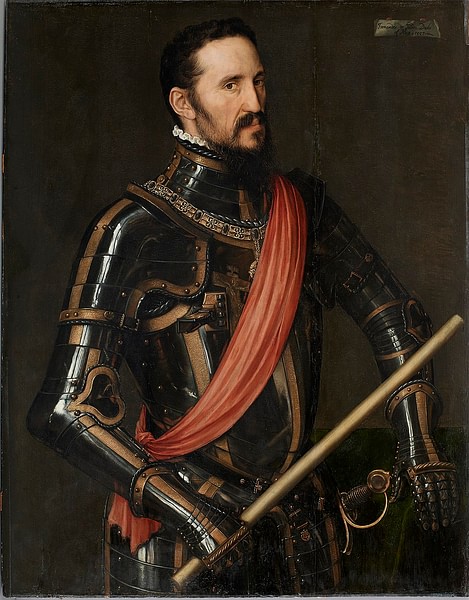
The Lutheran princes, aware of Charles V's mobilization, agreed it was in their best interests to strike first but not on how this was to be done. Martin Luther, who had denounced rebellion against a monarch save under certain circumstances, had died in February 1546 and so could not object to proposals of armed rebellion. Still, there were some princes who adhered to his view and stopped short of full support. The League continued the policies it always had, only now with some members more fully mobilized for war, and took the Catholic village of Fussen, provoking the invasion that Philip I and John Frederick had hoped to stop before it could happen.
The Schmalkaldic War
The Schmalkaldic War lasted less than a year and was characterized by the very lack of unity among the Lutheran princes that Charles V had objected to regarding his subjects generally at Augsburg in 1530. Philip I of Hesse and John Frederick had deposed the Catholic duke, Henry V of Brunswick-Lüneberg (l. 1489-1568) in 1542, confiscating his lands. Henry V, with the support of Charles V, mobilized against them in 1545 to reclaim his territories but was defeated and captured. Charles V placed both Philip I and John Frederick under imperial ban in 1546, declaring them outlaws, and this cost them the full support of the southern Protestant princes, who were reluctant to declare outright rebellion against the emperor.
Philip I and John Frederick pressed their attack on the emperor's forces in the fall of 1546, but Maurice, with the support of Ferdinand I, invaded John Frederick's territories, forcing him to withdraw and drive Maurice's forces out. He then invaded Maurice's territory before winter weather halted hostilities. When the war resumed in March, Charles V's forces under the Duke of Alba were mobilized and united while those of the Schmalkaldic League were essentially disparate armies fighting on their own.
The lack of unity between the northern and southern princes left John Frederick fighting on his own when, in April of 1547, he encamped near the town of Mühlberg on the right bank of the River Elbe. John Frederick was leading a sizeable force, and although he was aware that Charles V's army was nearby, he did not believe they would attack, especially considering that the River Elbe was between them and there was no way to cross, save by a pontoon bridge guarded by his men. Since the likelihood of an attack seemed so slim, however, few guards were stationed there or elsewhere along the perimeter of the camp.
On the 23rd of April, a thick fog rolled in, allowing Charles V to send scouts swimming across the Elbe undetected who killed a number of the Saxon guards and secured the pontoon bridge while, at the same time, the Duke of Alba located a ford he ordered the army across. By the next day, 24 April, Charles V's army was mobilized around the camp before John Frederick even knew they had crossed the Elbe. He positioned himself with his army's back to a forest to keep from becoming surrounded and prepared a defense, but Charles V's cavalry, led by the Duke of Alba on the right and Maurice on the left, broke their lines, and the Duke of Alba then ordered in his crack troops from the center, who tore into what was left of John Frederick's lines, scattering them. John Frederick was wounded, taken captive, and imprisoned.
The Battle of Mühlberg was a decisive victory for Charles V who, though afflicted with gout at the time so seriously that he had to be carried to the battle on a litter, immortalized his triumph later through his portrait by the artist Titian. MacCulloch comments:
Charles profited both from commanding a much larger army than the Elector's and from a surprise attack; it was one of the high points of his life and he commemorated it with a portrait by Titian which has become one of the most famous images of the Emperor, in full armor on his horse, a chivalric knight resplendent in the cause of God and the Empire. (272)
The Saxon army suffered almost 3000 casualties to Charles V's 50-60. Philip I of Hesse, recognizing the cause was lost, surrendered himself and begged for mercy but was imprisoned and, afterwards, the cities that had supported him and John Frederick were heavily fined, and the Schmalkaldic League was dissolved.
Conclusion
Charles V convened another Imperial Diet of Augsburg in 1548 after which he issued the decree known as the Augsburg Interim, whose aim was to bring the Protestants back into line with Catholic doctrine while at the same time making concessions he felt they would (or should) accept such as the practice of clerical marriages and communion of both bread and wine offered to the laity. The Augsburg Interim only caused more division, however, as hardline adherents of both sides considered compromise a sin. Philip Melanchthon tried, as he had in 1530, to advocate for peaceful negotiations in reaching an accord, but this was impossible.
The Protestant princes of Northern Germany entered an alliance with Henry II of France (r. 1547-1559), who invaded Germany in 1551 with their support. A number of German cities that had supported Philip I of Hesse and John Frederick still had not paid their fines to the emperor, and so this same year, Maurice of Saxony was sent by Charles V to punish one of them, Magdeburg, and return with the fines. Maurice's reputation had been suffering since the defeat of the Schmalkaldic League in 1547 as the other northern princes considered him a traitor. Seeing a way to redeem himself, Maurice allied himself with Henry II, spared the city of Magdeburg, and joined the French king in 1552 in subduing the southern cities that were loyal to Charles V.
This year of conflict is known as the Second Schmalkaldic War, or the Princes' Revolt, which ended with the Peace of Passau of 1552. Philip I of Hesse and John Frederick were released from prison, along with other captives, and the German princes ended their alliance with France. Charles V understood now that the Protestant movement had established itself too firmly to be suppressed or silenced, and the Peace of Passau formed the basis for the Peace of Augsburg in 1555, recognizing Lutheranism as a legitimate belief system. The Calvinists, followers of the reformer John Calvin (l. 1509-1564), continued to be persecuted, however, and religious tensions would continue, contributing to the conflict of the Thirty Years' War (1618-1648), which killed at least 8 million people and destroyed the regions that had survived the battles of the Schmalkaldic Wars.
